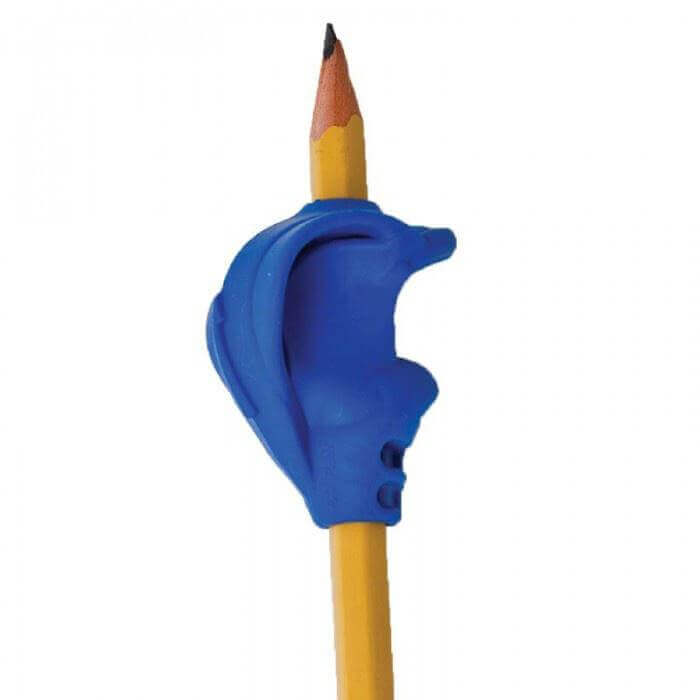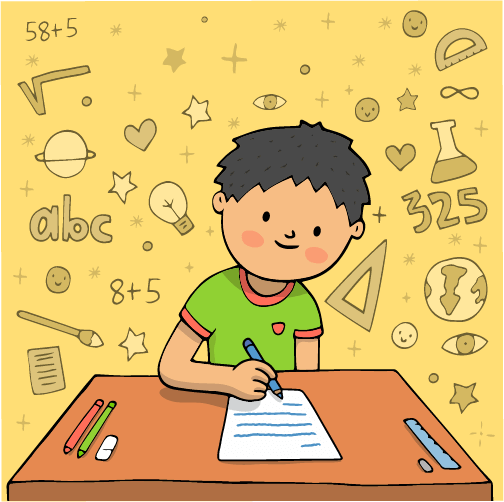
Effective Strategies for Improving Children’s Handwriting Skills
Here are some practical tips for supporting children’s handwriting skills development. If you are interested in fundamental handwriting skills, click here to explore our introductory articles covering children’s handwriting development across different ages. Now, let’s dive in and have a look at the practical tips and activities for you and your children to enjoy together.

Setting the Scene: Creating the Ideal Learning Environment
A distraction-free environment, free from bustling surroundings and disruptive noises, is always beneficial for children’s learning. The age-old adage “Tidy desk, Tidy mind” holds true. Encouraging children to declutter from a young age can help them cultivate the habit of maintaining an organised and clean workspace, thereby boosting their organisational skill development.
In the context of handwriting, it’s essential to provide a table or surface that suits your child’s height. This is crucial for their posture and, naturally, their performance.

- The table should feature a writing surface slightly higher than the child’s bent elbow position when seated. This ensures that children engage in tasks with an upright posture.
- Ensure that the child’s feet are adequately supported. It’s ideal for children to sit with their feet flat on the ground or on a stool/footrest, as this promotes proper sitting balance during tabletop tasks.
- Position children close to the table and encourage them to place the page 1-2 inches away from the edge of the table, with their forearm and wrist resting on the surface. To achieve a better wrist angle while writing, right-handed children can slightly tilt the page towards their left side, while left-handed children can tilt their page towards their right side.

Useful Equipment:
Short Chunky Crayons: Break these chunky crayons into approximately 2 cm lengths and encourage children to use them for colouring and tracing. This prevents children from relying on a palmer grasp while holding the crayon. Gradually increase the length of the crayon as children develop a more mature grasp.
Short Pencil: Transitioning to adult-sized pencils from the start can be challenging for children. Facilitate their learning with shorter pencils, which provide better balance.
Pencil Grip: Pencil grips come in handy for introducing a functional pencil grasp to children. There are various pencil grips available on the market, each with unique functions.
A few recommendations for your consideration:

This grip is excellent for demonstrating the most efficient thumb and finger placement on the pencil. It’s conveniently sized and features an ergonomic bump that comfortably fits the thumb, index, and middle fingers.

This grip not only offers an ergonomic design to encourage a functional tripod grasp but also maximises the size of the pencil, reducing the force required for gripping during writing.

This grip aids children in forming a tripod grasp without tucking the thumb under the index finger or wrapping the thumb over the index finger.
Rubber Band/Marking:To ensure the best visibility while writing, maintaining a grasp around 1-2 cm away from the pencil’s nib can be very helpful. To teach children the correct grasp position on the pencil, consider placing a rubber band or sticker on the pencil as a visual and tactile prompt.

Age-Appropriate Activities:
It is crucial to remember that children are more motivated when engaged in age-appropriate activities, as these activities facilitate better learning. Here are three examples for children at different developmental stages:

1. First-Time Writers: Developing Fine Motor Skills and Handwriting Together
Fine motor skills and handwriting skills are closely linked in a child’s development. Enhanced in-hand manipulation, dexterity, and hand strength play a pivotal role in a child’s ability to acquire penmanship skills. Incorporating fine motor tasks, including activities that strengthen the shoulders and hands, can be highly effective. For instance, games involving clips can promote a child’s pincer grasp. Engaging with scissors and playing with playdough (or theraputty) can significantly improve hand strength, leading to better handwriting quality and endurance.

2. Colouring Books, Mazes Books, and Sticker Books for Novice Scribblers and Colourers
For early learners, these activities are excellent for introducing children to the world of pencil and crayon, allowing them to draw lines and shapes, as well as practice colouring. To boost their interest and engagement, consider selecting books featuring their favourite cartoons, colours, or animals. Sticker books are a fantastic way for children to practice their fine motor skills (specifically their pincer grasp) and enhance eye-hand coordination.


3. Handwriting Practice for School-Age Children
Recognising that handwriting is a skill honed through practice, it is important not to overburden children with repetitive exercises. Instead, try sparking their interest in writing by involving them in creative activities, such as making celebration cards, maintaining a daily diary, or crafting their own interest journal focused on their favourite shows, cars, sports, and more. Once children establish a daily writing routine, you can then concentrate on improving their handwriting quality, refining letter formation, baseline orientation, spacing, and other essential aspects.

If you have concerns about your child’s handwriting performance, it’s advisable to consult with a GP, a Paediatric Occupational Therapist, or an Educational Psychologist for a comprehensive assessment of their learning and handwriting capabilities. Interventions and targeted practices have proven effective in enhancing children’s handwriting quality, which can lead to improved learning and communication outcomes.
For more information on supporting children’s handwriting development, please stay connected with HatchDraw Children Resources for more valuable strategies. Thank you for reading, and we look forward to sharing more tips and resources with you in the future!
Duiser, I. H., Ledebt, A., van der Kamp, J., & Savelsbergh, G. J. (2020). Persistent handwriting problems are hard to predict: A longitudinal study of the development of handwriting in primary school. Research in Developmental Disabilities, 97, 103551.
Enable Ireland. Pre-Writing Booklet For Parents and Pre School/ Schools. Retrieved October 24, 2023, https://enableireland.ie/sites/default/files/publication/Handwriting%20Booklet%20final.pdf
Feder, K. P., & Majnemer, A. (2007). Handwriting development, competency, and intervention. Developmental Medicine & Child Neurology, 49(4), 312-317.
Gosse, C., Parmentier, M., & Van Reybroeck, M. (2021). How do spelling, handwriting speed, and handwriting quality develop during primary school? Cross-classified growth curve analysis of children’s writing development. Frontiers in Psychology, 12, 685681.
James, K. H., & Engelhardt, L. (2012). The effects of handwriting experience on functional brain development in pre-literate children. Trends in neuroscience and education, 1(1), 32-42.
NHS Cambridgeshire Community Services. Developing Pencil Grasps. Accessed 24 October 2023, https://www.cambscommunityservices.nhs.uk/Bedfordshire/services/occupational-therapy/ot-leaflets/development-of-pencil-grasps
N, Smet and C, B, Lucas. (2020). Occupational Therapy View of Child Development. Case-Smith’s Occupational Therapy for Children and Adolescents. Missouri: Evolve, pp76-121.
Overvelde, A., & Hulstijn, W. (2011). Handwriting development in grade 2 and grade 3 primary school children with normal, at risk, or dysgraphic characteristics. Research in developmental disabilities, 32(2), 540-548.
Pritchard, V. E., Malone, S. A., & Hulme, C. (2021). Early handwriting ability predicts the growth of children’s spelling, but not reading, skills. Scientific Studies of Reading, 25(4), 304-318.
Raising Children Network. Handwriting Skills for Children. Retrieved October 24, 2023, https://raisingchildren.net.au/toddlers/play-learning/learning-ideas/handwriting
